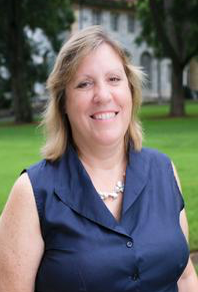In This Story
Chair of the Department of Global and Community Health Carolyn Drews-Botsch continues her study of unilateral congenital cataracts by studying the risks and benefits of prolonged patching in preschool-aged children.

Children with unilateral congenital cataracts (UCC) are born with cloudy or opaque vision in one eye that, if left untreated, can result in blindness. The condition is treated, as it is in adults, by removing the lens. Glasses, contacts, or implanting an artificial lens are needed to replace the focusing power of the natural lens. Occlusion therapy, also known as patching, is when the child wears a patch covering one eye and it is needed to strengthen the eye after treatment. However, even with the best treatment, about half of these children will remain legally blind in the treated eye. Further, it can be difficult for parents to get children to wear the patch consistently for the required amount of time.
With a $457,00 (directs and indirects) National Institutes of Health R21 grant, Carolyn Drews-Botsch, professor and chair of the Department of Global and Community Health, is studying the effects and benefits of patching in preschool aged children.
“The ultimate goal is to advise parents and health care providers about how to improve visual acuity and how long to continue patching if a child is born with a unilateral congenital cataract,” said Drews-Botsch. “Even with patching, a high proportion of children do not develop usable vision in the treated eye. Therefore, the usefulness of extended patching in eyes destined to have poor vision is unclear, and the costs of therapy need to be weighed against possible benefits.”
Currently, children treated for UCC are advised to patch the unaffected eye for 50% of waking hours throughout the first 5-6 years of life and often into the elementary school years. Adherence to this guideline can be difficult for parents and children, and there are few evidence-based tools to help families. Additionally, vision improvement is not a guarantee with patching, so it could ultimately negatively affect the child. Even with early surgery and consistent patching, relatively few children develop adequate vision by the time they enter school.
The project, “Secondary Analyses of data from the Infant Aphakia Treatment Study: Patching in Children with Unilateral Congenital Cataracts and Poor Visual Acuity,” leverages unique secondary data collected in the Infant Aphakia Treatment Study (IATS). Researchers will provide guidance on how to establish patching habits that may improve outcomes, and conduct cost and benefits analysis of patching in the latter part of preschool. Researchers will determine whether it is possible to accurately identify children who will ultimately have little usable vision in their affected eye using information collected in the first four years of life and if prolonged patching in children who ultimately will not see well impacts their quality of life.
The IATS is a randomized controlled trial designed to compare two treatments for UCC: leaving children without a lens in their eye (aphakic) so that they need to wear glasses or a contact lens versus implanting an artificial lens (pseudophakic) at the time of cataract surgery. The primary study is one of the largest currently available cohorts of children treated for UCC and has provided important evidence about outcomes in these children prior to school entry.
Drews-Botsch and fellow researchers Scott Lambert from Stanford University, Marianne Celano and George Cotsonis from Emory University, and Genie Hartmann from Akron Children’s Hospital have worked with the IATS for over 15 years. Assistant Professor in the Department of Global and Community Health Jaffer Zaidi is new to the team.
